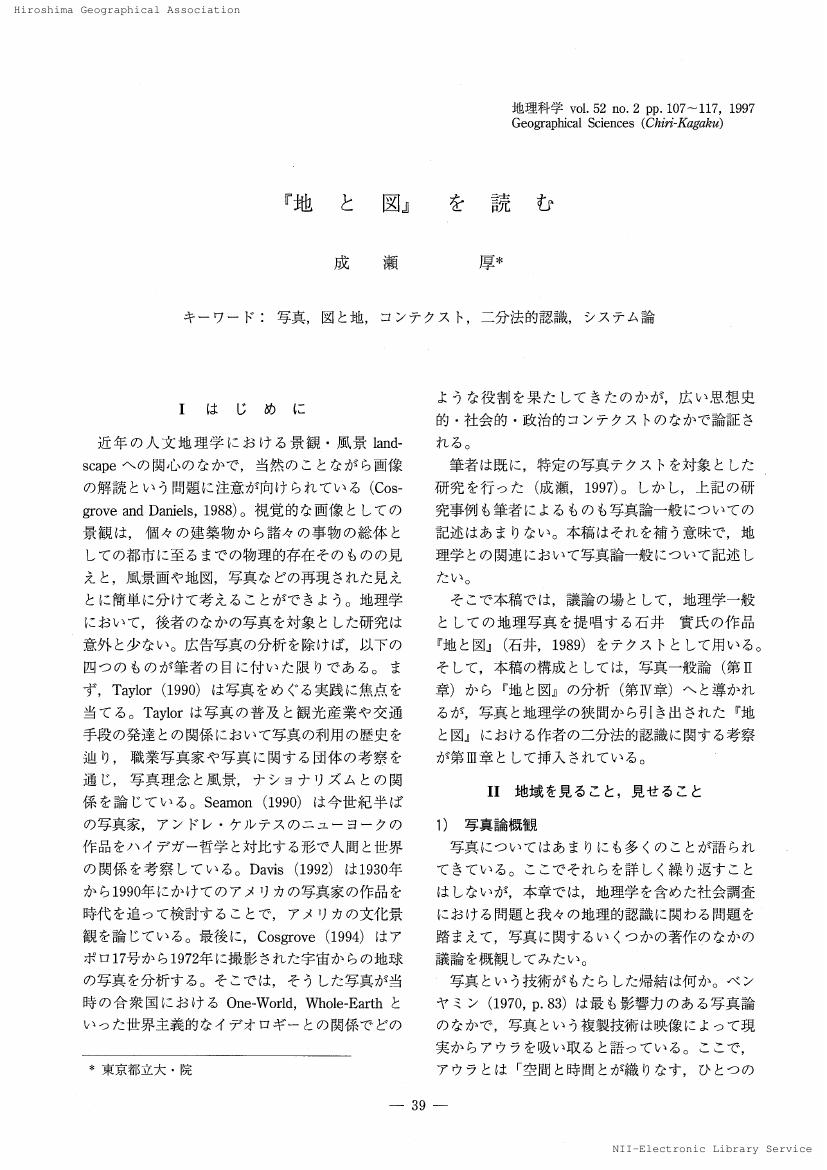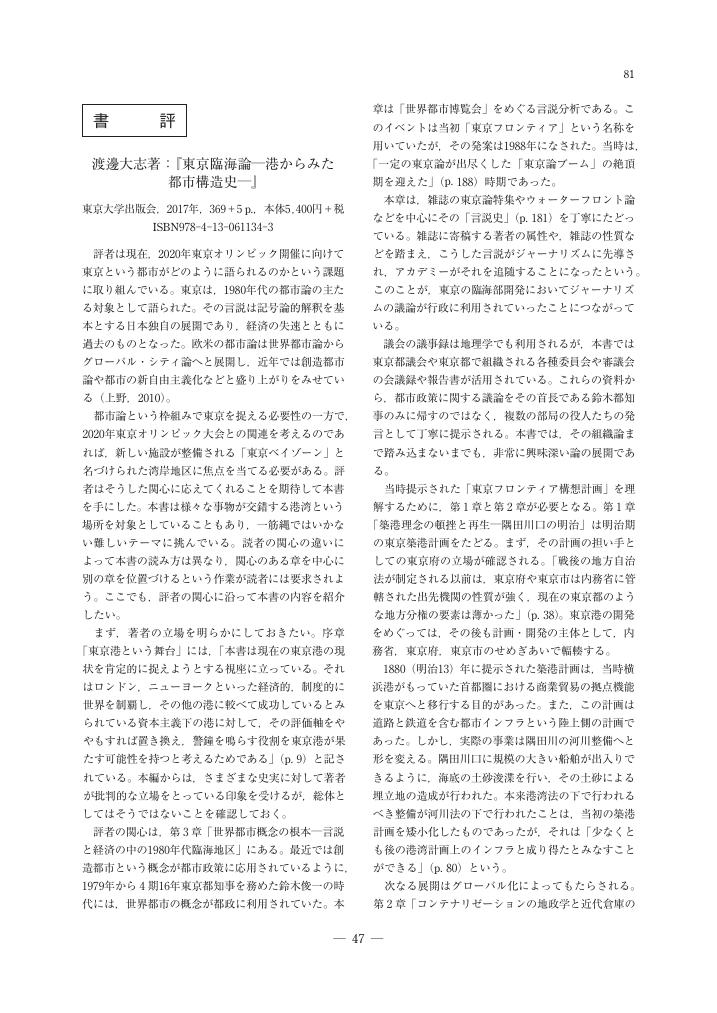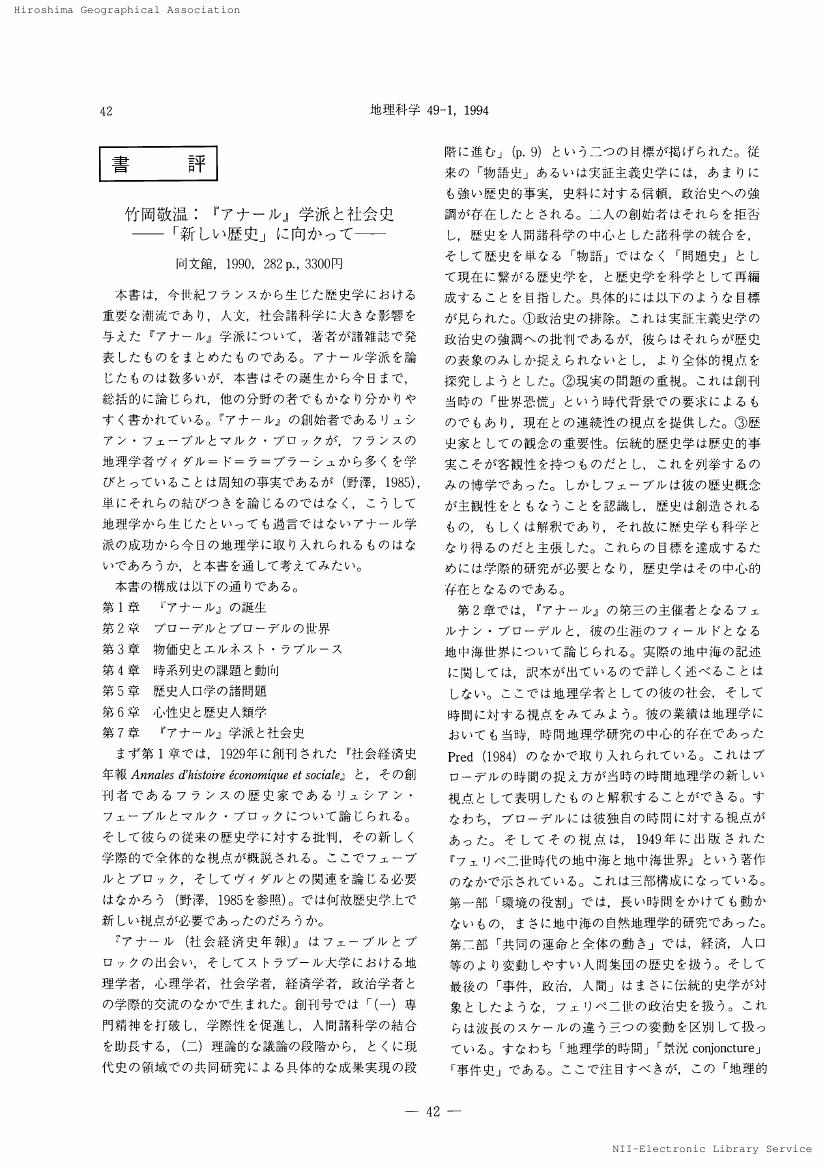- 著者
- 成瀬 厚
- 出版者
- 一般社団法人 人文地理学会
- 雑誌
- 人文地理 (ISSN:00187216)
- 巻号頁・発行日
- vol.73, no.2, pp.222-223, 2021 (Released:2021-07-14)
- 著者
- 成瀬 厚
- 出版者
- 地理科学学会
- 雑誌
- 地理科学 (ISSN:02864886)
- 巻号頁・発行日
- vol.49, no.4, pp.243-247, 1994 (Released:2017-04-27)
1 0 0 0 2020年学界展望 文化地理
- 著者
- 成瀬 厚
- 出版者
- 一般社団法人 人文地理学会
- 雑誌
- 人文地理 (ISSN:00187216)
- 巻号頁・発行日
- vol.73, no.3, pp.300-304, 2021 (Released:2021-10-31)
- 参考文献数
- 42
- 著者
- 成瀬 厚
- 出版者
- 公益社団法人 日本地理学会
- 雑誌
- 日本地理学会発表要旨集 2022年度日本地理学会春季学術大会
- 巻号頁・発行日
- pp.25, 2022 (Released:2022-03-28)
スポーツの国際大会において,出場選手は地理的環境の異なる場での競技パフォーマンスを高めるために事前合宿を行う。東京2020五輪大会では,政府が事前合宿の場を全国から募り,ホストタウン政策を実施した。共生社会ホストタウンはパラリンピック選手の事前合宿を受け入れるもので,競技施設や宿泊施設,また交流事業を行う公共施設などのバリアフリー化が事業計画に含まれる。 日本の障害者政策には2006年のバリアフリー新法があるが,東京2020大会は施設整備を推し進める契機として期待された。共生社会ホストタウンの事業計画には,地方自治体にとって福祉のまちづくりの推進への期待が読み取れる。全105の登録自治体の事業計画を整理すると,直接パラリンピックに言及するものよりも当該自治体の福祉政策を反映しているものが多い。スポーツ施設だけでなく,教育施設や交通インフラ,観光施設,防災関係の計画も少なくない。ソフト面ではバリアフリーマップや啓発用パンフレットの作成,障害者関連条例に関する記述などもある。自治体のウェブサイトでは事前合宿の様子が報告されているが,具体的な施設整備の状況は確認できない。そこで,自治体の予算書から五輪関連予算の内訳を確認した。4市の事例から,施設整備とその財源,地方都市におけるスポーツ・イベントの存在,ツーリズムとの関連と新型コロナウイルス感染症対策,オリンピックを契機としたまちづくり計画の加速化が明らかにされた。諸施設のバリアフリー化の詳細や,政府の財政支援の詳細については明らかにできなかった。ホストタウン政策を通じて全国に分配しようとした五輪大会の効果は限定的なものとなったが,各自治体の取り組みは福祉のまちづくりをある程度推進したといえよう。
1 0 0 0 地理学関連科目を担当する大学非常勤講師の雇用実態と意識
- 著者
- 成瀬 厚
- 出版者
- 公益社団法人 日本地理学会
- 雑誌
- E-journal GEO
- 巻号頁・発行日
- vol.12, no.2, pp.280-293, 2017
- 被引用文献数
- 1
<p>大学非常勤講師の処遇に関する議論は1990年代以降なされており,2007年前後に盛り上がりをみせていたが,大きな改善がみられないまま現在に至っている.2013年には労働契約法が改正され,非正規の有期労働契約を無期契約へと転換する道が開かれたが,逆にそのことが「雇い止め」という事態を拡大させる契機となっている.本稿で筆者は,そうした議論を整理し,大学で地理学関連科目を担当する本学会員の大学非常勤講師にアンケート調査を行った.回答者15人の属性として,講師歴15年以上および年齢46歳以上が回答者の半数以上を占めた.かれらの収入は週1コマ当たり月額で30,000円以下がほとんどで,かれらは4校程度を掛け持ちしている.大学の非常勤講師で生計を立てている専業非常勤講師は,平均週8コマを担当しているという状況が確認された.</p>
1 0 0 0 OA 『地と図』を読む
1 0 0 0 IR 地名の認識論序説
- 著者
- 成瀬 厚
- 出版者
- 大阪市立大学都市研究プラザ
- 雑誌
- 空間・社会・地理思想 = Space, society and geographical thought (ISSN:13423282)
- 巻号頁・発行日
- no.23, pp.3-12, 2020
本稿は, 地名研究における新しい方向性を見出そうという試みである. 地名は大小の空間スケールを有する地理的実体に付された名称であり, 階層性を有する. ……
1 0 0 0 人と街を繋げる音楽
- 著者
- 成瀬 厚
- 出版者
- 公益社団法人 日本地理学会
- 雑誌
- 日本地理学会発表要旨集
- 巻号頁・発行日
- vol.2011, pp.108, 2011
I はじめに下北沢は演劇の街でありながら,近年では音楽ライヴを提供する店舗の集積により,音楽の街としての様相を呈してきている。毎年7月にはそのライヴ施設の集積を活かした「下北沢音楽祭」が開催されている。一方,下北沢の街はここ数年,「都市計画道路補助54号線」と駅前広場を含む「区画街路10号線」の建設計画をめぐって様々な動きが展開している。本報告では,下北沢でライヴ活動を行っているミュージシャンたちを取り上げ,かれらの下北沢との関わりについて考察する。特に,この建設計画をめぐる動きが顕著であった2005年を中心にミュージシャンたちのこの街との関わり方を明らかにしたい。II 音楽的社会関係2005年の5月に雑誌『SWITCH』は「下北沢は終わらない」という特集を組んだ。芸能界からは,この街で生まれ育った小池栄子,演劇界からは原田芳雄が登場し,作家の片岡義男はこの街を舞台とする短編小説を寄稿した。音楽界からは曽我部恵一やクラムボンの原田郁子,小島麻由美,UAなどのメジャー・アーティストが名を連ねているが,本報告で取り上げるのは,かつてメジャー・レコード会社との契約もしていたが,現在は下北沢の施設を含むライヴ活動を中心にしているミュージシャンたちである。また,本報告では具体的な社会運動としての下北沢再開発反対派の団体について詳細に報告することはしない。反対派の団体で代表的なのは「Save the下北沢」だが,ミュージシャンたちはそれらと緩やかに関係を持ったり,その主張に大枠で同意したりしているが,必ずしも自らが主体的に運動に参加するわけではない。むしろ,自分たちにできるのは音楽活動だけだと割り切っているともいえる。ただし,こうしたミュージシャンたちは明らかにこの街,下北沢に愛着を持っていて執着している。かれらはそれぞれ好んで定期的に出演しているライヴ施設を下北沢にもち,自ら企画するイヴェントも定期的に開催している。また本報告では報告者を含むオーディエンスの行動もたどっている。表1には,対象とするミュージシャンが2005年に行ったライヴ本数と下北沢での内訳を示した。かれらは,こうした特定の街でのライヴ活動を通して,ミュージシャン同士,ライヴ施設の経営者や従業員,そしてオーディエンスたちと関係を結ぶ。かれらのなかには下北沢周辺での居住暦を持つものもあり,仕事場として,居住地としてこの街と関わっている。朝日美穂が2005年11月にライヴ演奏で参加したイヴェント「シモキタ解体」は下北沢のタウン誌『ミスアティコ』が主催したもので,「Save the下北沢」の代表や,社会学者の吉見俊哉もトークセッションに参加したものである。III 街の音楽的風景朝日は単独で,HARCOは南風というグループへのゲストという形で,シリーズCD「sound of shimokitazawa」に参加している。特に,朝日の「ドットオレンジ模様の恋心」という楽曲は下北沢的要素をふんだんに盛り込んだもの。朝日は他にも下北沢のカレー店のドリンクメニューをタイトルにした楽曲もある。HARCOは2004年発売のCDに収録された楽曲「お引越し」のプロモーションヴィデオを下北沢中心に撮影している他,2002年発売のCD『space estate 732』の冒頭で,下北沢で賃貸住宅を探す青年に扮している。ハシケンは2006年から下北沢のライヴ施設「440」で隔月イヴェントを開催し,その集大成として制作したCD『Hug』(2007年)にはそのテーマソング「下北沢」が収録されている。そこではのんびりとしたテンポの曲に,自らの日常的行動のように,下北沢南口界隈をブラブラと歩く様子が描写されている。IV おわりに報告者はこれまで,文化的作品における場所の表象分析を通して,場所と人間主体のアイデンティティの関係について論じてきた。本報告では,作品自体の考察も含むが,そのパフォーマンスの場としての場所との関わり合いについても考察した。また,社会運動研究が明らかにしてきたような,場所に対する明確な帰属意識を有する共同性ではなく,下北沢という商品的街に相応しい緩やかな共同性によって,開発反対運動に同調する思想が共有されている。文 献中根弘貴 2010. 下北沢に創られる共同性の民族誌:ロックバンドと市民運動グループの繋がり.南山大学大学院2009年度修士論文(未入手)
1 0 0 0 メガ・イベント研究からオリンピック研究へ:―地理学的主題の探求―
- 著者
- 成瀬 厚
- 出版者
- 経済地理学会
- 雑誌
- 経済地理学年報 (ISSN:00045683)
- 巻号頁・発行日
- vol.66, no.1, pp.3-28, 2020
<p> 本稿は,英語圏におけるオリンピック研究を整理したものである.本稿で取り上げたオリンピック研究の多くは,上位分野であるメガ・イベント研究に位置づけることができ,学際的な観光研究から発したこの分野には都市社会学や地理学の貢献が大きかった.オリンピックという複雑で大規模なイベントの性質上,本稿では多様な研究分野を扱っているが,オリンピック研究における都市研究を含む広義の地理学的な主題を探求するのが本稿の目的である. <BR> IIIでは初期のイベント研究における社会的インパクトの分類―経済,観光,物理的,社会・文化的,心理的,政治的―に従って,多様な分野におけるオリンピック研究を概観した.IVでは地理学的主題をもった研究に焦点を合わせ,オリンピック都市,グローバル都市間競争,都市(再)開発,レガシー・環境・持続可能性,市民権と住民参加という分類で整理した. <BR> 地理学者によるオリンピック研究は2000年前後から,過去の開催都市を概観する形で,それ以降盛り上がりをみせる地理的主題を持つオリンピック研究を牽引したといえる.当初から国際的なイベントであった近代オリンピック競技大会は,今日において大会招致がグローバル都市間競争の一端となり,大会関連開発は新自由主義的な都市政策の下で官民連携によって行われている.さまざまな問題を抱え,オリンピックはどこに向かうのだろうか.</p>
1 0 0 0 OA 他所と同一化する―写真家が旅で発見した故郷―
- 著者
- 成瀬 厚
- 出版者
- 一般社団法人 人文地理学会
- 雑誌
- 人文地理 (ISSN:00187216)
- 巻号頁・発行日
- vol.62, no.5, pp.478-492, 2010 (Released:2018-01-19)
- 参考文献数
- 83
This paper analyses the photographic works of Tanuma Takeyoshi who travels around the world. Although he is most famous for what he has made his life’s work, ‘Children of the World’, he has also produced works focused on Tokyo where he was born, grew up, and currently lives. Through the course of his world travels, he has identified particularly deeply with two regions, the Andes in South America and the Catalonia region of Spain, and has published books of photographs that were specifically devoted to each region. This paper investigates the process of his identification with these regions through the analysis of his photographs. By producing these photographs, Tanuma has acquired a sense of belonging to other places.Andes Sanka (Homage to the Andes) was published in 1984. This photo collection consists of all color photos which were taken on a journey in the 1970s. They include photographs of magnificent natural landscapes, the daily life of the Indios who live there, scenes of their festivals, the remains of the Inca Empire, and the geoglyphs of Nazca. The photographs of natural landscapes give viewers a sublime sense of vastness and spirituality.Romànic Català (Catalan Romanesque) was published in 1987. The monochrome photographs of Romanesque-style medieval buildings were taken in the mid 1980s. The buildings have been weathered through a history of more than a thousand years, and they have become artworks appropriate to their surrounding as they balance the upward striving of human creative intention with the downward force of natural gravity.By grasping the fascination with other places through taking photographs from a traveler’s viewpoint and finding spirituality and universal commonality in other places, Tanuma pays homage to these places and a sense of belonging. While all human beings have homes where they were born and grew up, they create a layered identity by ‘belonging’ to other places, selected according to individual taste, which also function as a home.
1 0 0 0 OA 渡邊大志著:『東京臨海論―港からみた都市構造史―』
- 著者
- 成瀬 厚
- 出版者
- 地理科学学会
- 雑誌
- 地理科学 (ISSN:02864886)
- 巻号頁・発行日
- vol.73, no.2, pp.81-82, 2018-06-28 (Released:2019-08-21)
- 参考文献数
- 1
- 著者
- 成瀬 厚
- 出版者
- 地理科学学会
- 雑誌
- 地理科学 (ISSN:02864886)
- 巻号頁・発行日
- vol.65, no.1, pp.51-54, 2010-01-28 (Released:2017-04-14)
- 著者
- 成瀬 厚
- 出版者
- 地理科学学会
- 雑誌
- 地理科学 (ISSN:02864886)
- 巻号頁・発行日
- vol.56, no.2, pp.124-126, 2001-04-28 (Released:2017-04-20)
- 著者
- 成瀬 厚
- 出版者
- 地理科学学会
- 雑誌
- 地理科学 (ISSN:02864886)
- 巻号頁・発行日
- vol.54, no.2, pp.138-140, 1999-04-28 (Released:2017-04-20)
- 著者
- 成瀬 厚
- 出版者
- 地理科学学会
- 雑誌
- 地理科学 (ISSN:02864886)
- 巻号頁・発行日
- vol.52, no.4, pp.259-260, 1997-10-28 (Released:2017-04-20)
- 著者
- 成瀬 厚
- 出版者
- 地理科学学会
- 雑誌
- 地理科学 (ISSN:02864886)
- 巻号頁・発行日
- vol.50, no.3, pp.214-215, 1995-07-28 (Released:2017-04-20)
- 被引用文献数
- 2
- 著者
- 成瀬 厚
- 出版者
- 地理科学学会
- 雑誌
- 地理科学 (ISSN:02864886)
- 巻号頁・発行日
- vol.49, no.1, pp.42-44, 1994 (Released:2017-04-27)
- 著者
- 成瀬 厚
- 出版者
- 学術雑誌目次速報データベース由来
- 雑誌
- 人文地理 (ISSN:00187216)
- 巻号頁・発行日
- vol.49, no.1, pp.1-19, 1997
- 被引用文献数
- 6 1
How can we recognize this world with finite extent as a globe? This question is the starting point of this study. This question leads us to another one: how do we represent the world? In this paper, I examined some cultural texts which seem to contribute to our view of the world. The texts which I chose here are exhibitions or collections which consist of several hundred photographs taken all around the world, specifically, from The Family of Man held at The Museum of Modern Art, New York in 1955, through photos with a similar theme, to Takeyoshi Tanuma's works produced with the theme'children in the world'. In order to analyze such geographical representations, I adopted the method of literary criticism. Especially, I paid attention to the 'order'of each text.The feature of texts which I analyze in this paper is that while each photograph recorded the local context in which it was taken, these works themselves represented the global world. The globalist intent of these photographs was to promote cosmopolitanism, universalism, or humanitarianism, but it is sentimental and not persuasive. For example, photographs taken in the USA were 45% of all photographs carried in The Family of Man, and photographs of the Third World were distributed into specific sub-themes: labor, death, and war. The insistence of universality was asserted under the biological commonality of Man. Man is born, works, gets together, takes pleasure, feels sad, consists of male and female, belongs to a family, eats, talks, plays, suffers, and dies. Such a life path became a commonality among photographs of people around the world. On the other hand, in one text produced in 1994 by Tanuma' who has created many works in a Japanese context, photographs were arranged in order by region. I found a significant structure in the arrangement of this text. Compassion of Japanese on Third World people, identification with two continents, Africa and South America, as others for Japanese, and uninterchangeablity between advanced countries and Third World were found in the structure of this text.From this analysis, I gained the insight that the World Order is a projection of'a world'which is a logical unity consisting of whole objects and events in'the world' which is a concrete geographical space with finite extent. We can locate each event in a world informed by journalistic media about our world order as an idea which was formed by a world representation including the photographic texts selected here.










